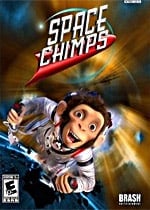A Solid, Kid-Friendly Platformer
Aside from Pixar and Dreamworks, computer-animated movies produced by other companies tend to get swept under the rug. This is usually for good reason. Pixar, in particular, treats animation as its medium of choice, while still telling a story that resonates with both kids and adults. Other companies treat animation as the ultimate end and wind up producing something that feels like an hour-and-a-half long cartoon. This is a review of Space Chimps the game, not the movie, but the analogy between movies and cartoons still fits. This game plays it safe as a platformer and makes it feel like you’re playing through a Saturday morning cartoon. There’s nothing wrong with this approach – it just never really pushes the game above average or beyond the audience of its low ESRB rating.
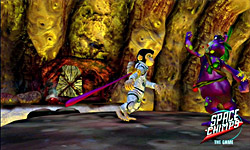
The smart money is that Brash Entertainment is banking on kids seeing the movie and then begging their parents for the game. This is apparent from the get-go by the game’s overall presentation. You’re treated to a well-rendered cinematic showing chimps in space suits running around a planet. However, you’re not given an introduction as to who all the characters really are. Again, this is probably because kids have already seen the flick and will say, “Oh, that character is Ham and that one’s Luna.” Eventually, you piece together the simple plot: the chimps are stranded on an alien world and have decided to help a species of aliens fight an evil dictator by the name of Zartog.
To take down this dictator and his alien army, the game puts you in control of the two previously mentioned space chimps: Ham and Luna. Ham can perform melee combos and double-jump, while Luna can fly using butterfly wings and enlists the help of Squirt – an alien that she straps to her arm which allows her to shoot goo while in a first person view. It would have been a nice feature to switch between characters during a level to solve puzzles, but since the game is aimed at a younger audience, the characters stratify the levels; if there’s lots of switches to shoot, it’s going to be a Luna level; if there’s more combat, then it will be Ham’s turn.
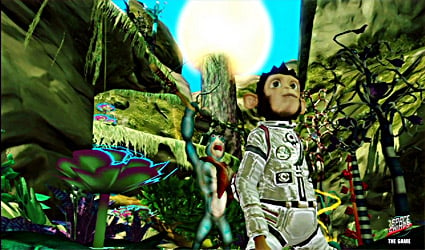
Whether you’re playing as Luna or Ham, every level breaks down into a mix of platforming, puzzle solving, and combat. When you first start running and jumping you’ll notice the game’s downgraded difficulty – you have an unlimited amount of lives and even something like falling into an endless pit doesn’t kill you; it merely checks off a little of your health and throws you back to the last checkpoint. To further curb difficulty, lots of objects have arrows placed on them as a way of queuing you into what exactly needs to be done. For example, poles have up arrows (indicating that you need to climb up) whereas some walls have a series of sideways arrows (this means you have to perform a Prince of Persia-like wall-run).
To keep the platforming fresh, there are a number of different locales – from the back of a giant walking alien to dense jungles, canyons, and alien fortresses; there’s enough variety to keep things interesting. And it’s true – the variety comes from the backdrops because the game doesn’t attempt to push the platforming envelope. You jump from rock-to-rock, climb up poles, race across crumbling bridges, and avoid razor-sharp traps. While all these things sound like platforming clichés (they are), it all feels pretty satisfying; maybe it’s the fact so many games now are action-based, but just jumping around environments feels like a throwback – in a good way – to simpler gaming.
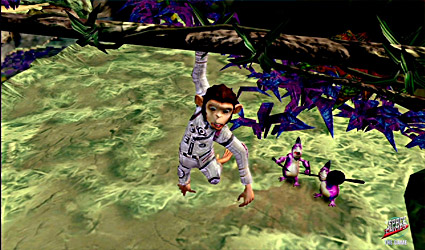
The puzzle solving and combat portions of the game are not as strong as the platforming. All puzzles in the game break down into either “flip this switch to open that,” “place this weight on that,” or “use the appropriate colored gem to open a door.” This approach does give the game consistency – you’ll see the same signs and, in turn, the same solutions to puzzles from level-to-level – but it also feels like uninspired design.
Platform-centric games usually don’t have great combat and Space Chimps is no exception. Luna can only perform one-hit attacks, whereas Ham can lay out a three-hit combo. The enemy A.I. is pretty rudimentary (characters waddle from side-to-side), so taking down an enemy is never all that satisfying.
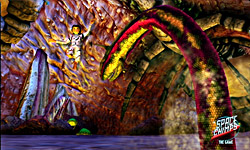
The designers tried to mix things up by including a Panzer Dragoon-like, on-rails shooter portion that has you flying on what looks like a stingray, but these levels have terrible controls. Trying to target enemies can be a pain; sometimes they fly to the edge of the screen where you can’t shoot them and then let out a string of shots.
Since Space Chimps is based on a computer-animated movie, the cutscenes come off as the best part of the visual package. These short scenes have fidelity on par with recent Pixar releases and work well as interstitials between levels. However, much of the in-game graphics just can’t measure up to the cutscenes. Most of the game looks like a previous generation title running at a higher resolution. The audio department is headed up by the Blue Man Group and it shows – a lot of the tracks have fantastic drumming paired with inventive instruments. It’s a shame that most of these tracks are locked away, forcing you to complete the game before you can hear them all.
Space Chimps is a short ride – maybe too short. Most gamers – even the young ones – should be able to complete the whole game in about three hours. To keep players coming back, each level has Dole bananas (there’s some good marketing) that players can pick up to unlock new costumes for the two main characters. Aside from that, there is some bonus concept art, arcade levels that play like on-rail shooters, and a level select that allows you to replay any level. On the 360, the game has no problem doling gamer points for simple achievements – you’ll get 20 for just watching the ending credits.
Spanning double the length of its on-screen counterpart, Space Chimps is a brief, albeit fun romp. There’s not a lot to really rag on and there’s not a lot to really applaud – “average” is the key word for this platformer. Kids should have a fun enough time, but don’t expect this title to push past its core audience.
RATING OUT OF 5 RATING DESCRIPTION 3.0 Graphics
The cutscenes are fantastic and have a Pixar-like quality. The in-game graphics don’t measure up; it looks like someone took a game from the last generation and gave it a resolution bump. 3.4 Control
Basic platforming is simple and there aren’t many button combinations to memorize. The flying levels are a wreck. 3.5 Music / Sound FX / Voice Acting
The music provided by the Blue Man Group is great and the voice acting should keep kids entertained. 2.8 Play Value
Heard of one-sitting games? Space Chimps is it – you can beat the entire game in just three hours. The bonus content won’t keep you occupied for much longer. 3.1 Overall Rating – Fair
Not an average. See Rating legend above for a final score breakdown.
Game Features:
